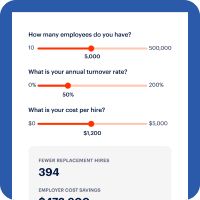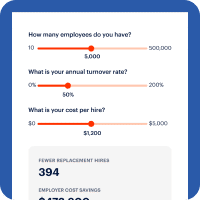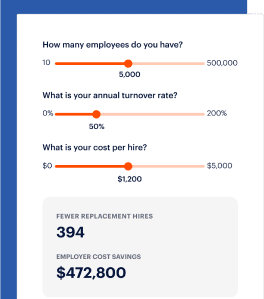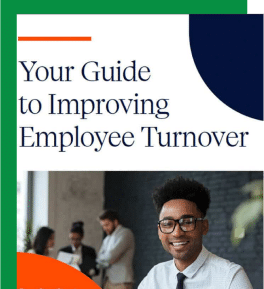Resource Center How to Reduce the Employee Turnover Rate at Your Company
How to Reduce the Employee Turnover Rate at Your Company
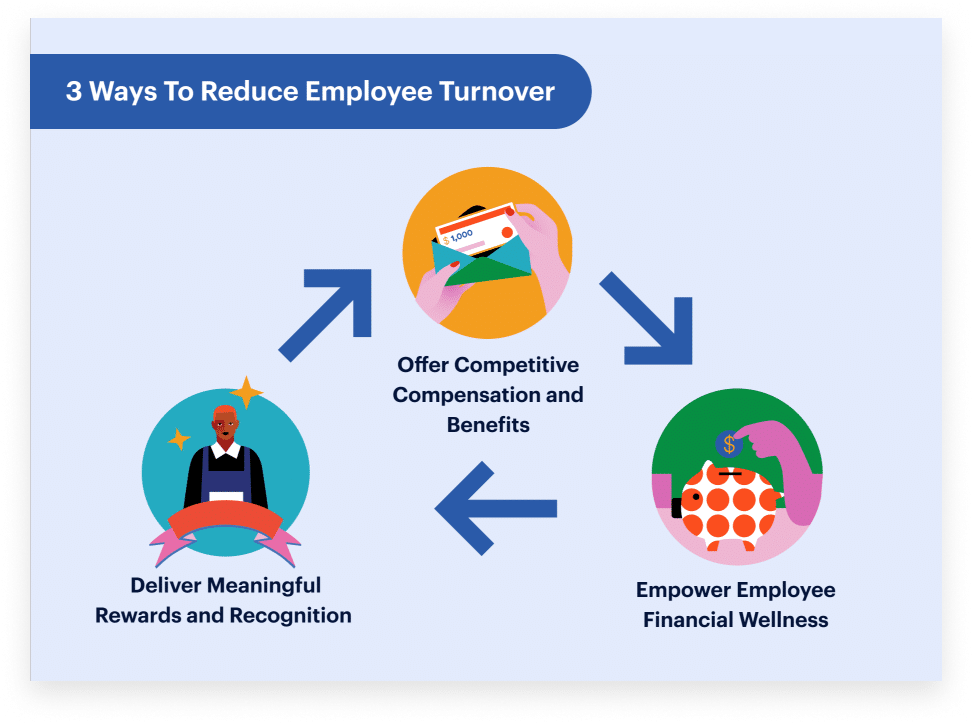
What is Employee Turnover?
Employee turnover refers to employees leaving an organization and being replaced by new employees. It is a measure of the rate at which employees join and leave a company over a specific period.
What Are the Types of Employee Turnover?
Employee turnover can be classified into two types: voluntary turnover and involuntary turnover.
1
Voluntary Turnover
This occurs when employees choose to leave the organization willingly. Reasons for voluntary turnover can vary and may include pursuing better job opportunities, seeking career advancement, dissatisfaction with the current job or work environment, relocation, retirement or personal reasons.
2
Involuntary Turnover
Involuntary turnover refers to employees being separated from the organization against their will. This can happen due to various reasons, such as poor performance, violations of company policies, downsizing, restructuring or disciplinary actions.
Employee turnover should not be confused with employee attrition, a term which specifically refers to the natural or gradual reduction in the size of the workforce due to employees leaving the organization without being replaced.
Attrition typically occurs through voluntary means, such as retirements, resignations or employees choosing not to renew their contracts. Attrition is often seen as a more passive form of employee turnover, where the organization doesn’t actively initiate the departure.
What Is an Employee Turnover Rate?
Employee turnover rate is the number of employees who leave your company during a given time period.
Employee turnover rate is an important metric for organizations, helping them to assess the effectiveness of their talent management strategies, employee engagement levels and overall work environment.
High employee turnover rates can be indicative of underlying issues, such as poor management, inadequate compensation, lack of growth opportunities or negative work culture. On the other hand, low turnover rates may suggest positive aspects like employee satisfaction, strong leadership and effective employee retention strategies.
By tracking and analyzing the employee turnover rate, companies can identify patterns, address areas of concern and implement strategies to improve employee retention and employee engagement, ultimately leading to a more stable and productive workforce.
How To Calculate Your Employee Turnover Rate
To calculate your employee turnover rate, divide the total number of employees who leave your organization in a month by the average number of employees at your company. Multiply this number by 100 to determine your employee turnover rate percentage.

Causes of a High Employee Turnover Rate
After you’ve calculated your employee turnover rate, it’s important to understand why employees leave. Here are some of the most common causes.
Financial Stressors
According to the 2022 PWC Employee Financial Wellness Survey, financially stressed employees are twice as likely to be looking for a new job.1
Poor Work-Life Balance
A poor work-life balance is not only potentially harmful to employee morale and well-being but also a significant driver of high employee turnover rates. Inflexibility in the workplace is a significant issue, and one growing even faster in a work environment with young people.
Insufficient Career Advancement Opportunities
A lack of potential for career growth and professional development can hurt your company’s turnover rate. If your company doesn’t offer growth potential, you should consider how to upskill and train high-potential employees, minimizing the chances of turnover.
The Negative Impact of High Employee Turnover
A high employee turnover rate can be detrimental to a company’s overall success. Some negative effects of a high employee turnover rate can harm your workplace culture, inhibit your company’s ability to provide outstanding customer service and rack up a multitude of costs.
- Departure costs
- Lost production
- Recruiting costs
- Onboarding and training costs
How To Reduce the Employee Turnover Rate at Your Company
As explained above, a high employee turnover rate can bring about some negative effects on your company if left unaddressed. Productivity loss, reduced employee morale and increased hiring costs and training costs are just a few of the most common adverse effects.
To avoid these issues, companies should consider how they can reduce their employee turnover rate by increasing employee happiness.
There are a few methods to help keep employees happier and more engaged in their roles.
Offer Competitive Compensation and Benefits
A comprehensive benefits package that goes above and beyond competitors will give a hiring edge and contribute to employee appreciation and retention.
Competitive compensation means not only paying industry-standard wages, but also increased flexibility for how often employees can access their earned wages. Compensation involves not only how much an employee gets paid, but also how often.
Employees dealing with financial stress will see negative effects on performance and productivity.
Empower Employee Financial Wellness
Employers should consider how they can further support employees through financial wellness benefits. These benefits may help employees keep track of earnings and expenses, pay bills on time, budget for the future and more.
Deliver Meaningful Rewards and Recognition
Recognizing an employee for their hard work can play an important role in motivating and retaining employees. However, this reward should be meaningful and provide a tangible incentive for employees who’ve gone above and beyond in their roles.
These Companies Have Reduced Employee Turnover Rates With On-Demand Pay
Why Top Companies Trust DailyPay
Learn how our employer clients gain significant cost savings as well as reduced employee turnover and financial stress, leading to increased employee satisfaction.
Reduce Employee Turnover Rate With On-Demand Pay
According to a report by DailyPay and Mercator, an added benefit such as on-demand pay may increase employee retention for organizations.
Discover how on-demand pay may help bolster an employee retention strategy today.
Frequently Asked Questions
-
What are the two types of employee turnover?
Typically, employee turnover can be broken down into two major categories: voluntary and involuntary.
-
What is an employee turnover rate and how is it calculated?
To calculate your employee turnover rate, divide the total number of employees who leave your organization in a month (or a year) by the average number of employees at your company. Multiply this number by 100 to determine your employee turnover rate percentage over that time period.
-
What is a good employee turnover rate?
While it can vary based on industry and economic conditions, a general rule of thumb is that 10% is the average turnover rate.
-
Why is it important to reduce your employee turnover rate?
Reducing your employee turnover rate can result in greater productivity, happier employees and cost savings.
-
How do you reduce your employee turnover rate?
To reduce your employee turnover rate, your company should focus on supporting employees through competitive benefits and pay, a good work-life balance and room for career growth.
-
Which industry has the highest employee turnover rate?
In 2022, leisure and hospitality had the highest turnover rate (annual average job openings) across all industries, according to the BLS.2
-
How does high turnover hurt productivity?
With higher turnover, employees may feel less motivated and engaged in their roles.
-
Does burnout lead to high turnover?
Yes, if an employee feels burned out in their role, they’re more likely to seek a new job opportunity with increased work-life balance.
-
Can flexible pay benefits reduce turnover rates?
Flexible pay can reduce a turnover rate and make employees more likely to stay with their current employer. According to a November 2022 DailyPay User Survey, 48% of users say they are more motivated to remain with their current employer because they offer DailyPay.
All information herein is for educational purposes only and should not be relied upon for any other use. The information herein does not constitute the rendering of professional advice by DailyPay. No fiduciary obligation or duty exists, or is created, between you and DailyPay. DailyPay does not warrant the completeness or accuracy of any information provided to you.
Related Content
SAVINGS CALCULATOR
See Why Top Companies Choose DailyPay
Empowering for Employees
Greater financial control with access up to 100% of their DailyPay balance to meet the challenges of unexpected financial disruptions.
Improved planning with visibility to spending and earned pay in one easy-to-use app.
No need for a pre-existing checking or savings account.
Simple and Secure for Employers
Minimal change to payroll processes — DailyPay handles it all.
Seamless integration with HCM, payroll, banking and benefit applications.
Enterprise-grade platform that keeps data private and the service running so it's always there when your employees need it.



